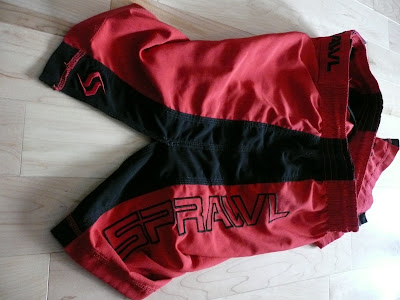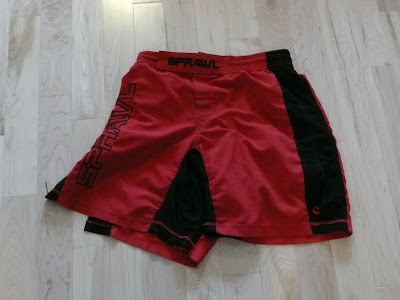I know that strength training and BJJ can be a contentious issue. I've heard many "Don't do it because. . ." arguments. It'll slow you down, it'll make you too heavy, you'll use your strength not your technique. Personally, I've tried doing BJJ with weight lifting and without. Without lifting I tend to lose muscle mass very quickly. With no weight lifting I was competing at 175lbs and always felt like the people I fought against were way stronger than me. With weight lifting I'm walking around at about 185-190. I've noticed that I get fewer injuries when carrying around a little extra muscle and in my mind, more mat time means better Jiu-Jitsu. That said, there are good and bad ways to lift weights, and I've tried to develop a strategy that seems to work for me the most in my BJJ. For me this involves compound lifts and lots of leg work.
I've broken up my weightlifting into two full body routines. I like to hit 3-4 jits classes a week, and when you throw in some jogging, the occasional soccer game, and some Muay Thai now and again there's I don't feel like there's enough time to add more sessions than that. Last night I completed my workout #1 . . . the goal of this workout is to develop power and some weightlifting endurance. My other workout is completely about generating power.
What I did last night (takes a little under an hour):
Clean and Squat (170lbs)
3 sets of 3 and 1 of 1
Bench (155lbs)
1 set of 10, 1 set of 7
Front Squat (155lbs)
2 sets of 5
1 Arm Row (80lbs)
1 set of 12, both sides
Standing Press (60lbs each hand)
2 sets of 5
Shrug (60lbs each hand)
1 set of 20
Pull-Ups (BW)
1 set of 12
Lunges (60lbs each hand)
1 set of 10, both sides
The
clean and squat is a great exercise. For each rep you power clean a weight from the floor up into the front squat racking position, then you do a front squat (all the way down to the bottom - don't get lazy), then lower the weight down to the floor. The exercise is done quickly and smoothly with about a minute and a half between sets. This exercises works a ton of the muscles in your body. It's especially great for your quads, hips, and traps . . . and these muscles get heavy use in most of your BJJ exercises (bridging, pulling the guy towards you, driving forward while standing, etc).
The
bench is done with endurance in mind. I'm aiming to get two sets of 10 out, but I'm still working towards that mark with this weight (I can do it with 150). I take about a minute between sets. Applicability: Framing when you're on the bottom!
 |
| Ass To Grass Front Squats . . . pure awesome. |
The
front squat is thrown in to add some extra work for the legs. Make sure it's a smooth, quick down and up motion, don't lean too far forwards, and squat ass to the grass. I like the front squat for a two reasons . . . it seems to really work your stomach and back muscles more than the back squat, and it's an easy lift to bail from (just throw the weight forward if it's too heavy). Bailing from the lift is important since I do my workouts in the basement without a spotter most of the time. About a minute and a half between sets seems good for this lift. Applicability: almost everything that the clean/squat is good for.
The
1-arm row motion is probably the most fundamental movement that you do in BJJ. Grabbing a guy's sleeve and pulling is used all the time be it arm drags, better positioning while standing, or setting up an armbar from guard.
The
standing press is the kind of exercise that lets you know how in shape you are. You start out with both dumbbells on the floor, then you grip them, drive your heels into the ground, and in one fluid motion push the weights up over your head. When you do them explosively you can feel your whole body working hard. It's kinda like doing a weighted burpee. Applicability: Well, it's got the squatting motion in there and you're using lighter weights so it's easier to explode quickly. I also like this one for the ab/back strength that you need as you're lifting the dumbbell up over your head.
The
shrug is something I'm thinking of taking out of my routine. I don't remember why started doing it originally . . . probably because it's a pulling motion. I'll be playing with taking it out and replacing with something better at some point in the future. I start standing with both dumbbells at my sides and raise them up as close to my armpits as possible.
Pull-ups. Everybody likes these. Palms towards your face, for some added grip (finger) strength I do these from a steel I-Beam in the basement. Since I can't grip the I-beam it forces me to hold my fingers at about 90 degrees to complete the pull-up. I tell myself that this is hardcore, but really I'm too cheap to buy a pull-up bar. :P
Finally the
lunges . . . if there were ever an exercise tailor made for doing a single leg, it's this one. Start standing with both feet apart, bring one leg out, and bring the rear leg knee down until it's just brushing the floor. Then step forward.
Important Note: Remember to always stretch after lifting! Stretch your legs, hips, arms, and back after each session and you will
GAIN flexibility, not lose it. Flexibility + Power = Awesome in Jiu Jitsu. All the usual other disclaimers apply as well. Start with low weight and perfect your form, then gradually ramp up from there.































